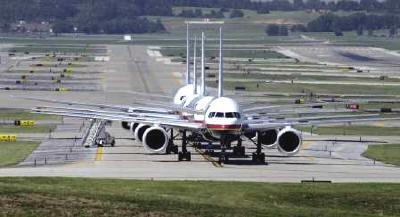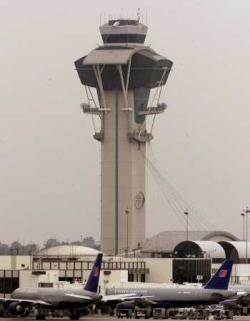President Bush Announces Administrative Steps To Reduce Delays,
Urges Congress To Act On Common Sense Reforms
 As previously detailed,
President Bush directed Transportation Secretary Mary Peters
(right) to take action to address air traffic congestion and flight
delays. President Bush has asked Secretary Peters to meet with
airline industry and aviation officials in the most over-stressed
part of our system – the New York metro airspace – to
develop a plan to alleviate congestion and reduce delays. A third
of the Nation's air traffic passes through this airspace, and
two-thirds of the Nation's air traffic can be affected when the New
York area experiences delays. This means delays there affect
travelers across the Nation. Secretary Peters will report back to
the President before the end of the year with proposed solutions
that could be in effect by next summer.
As previously detailed,
President Bush directed Transportation Secretary Mary Peters
(right) to take action to address air traffic congestion and flight
delays. President Bush has asked Secretary Peters to meet with
airline industry and aviation officials in the most over-stressed
part of our system – the New York metro airspace – to
develop a plan to alleviate congestion and reduce delays. A third
of the Nation's air traffic passes through this airspace, and
two-thirds of the Nation's air traffic can be affected when the New
York area experiences delays. This means delays there affect
travelers across the Nation. Secretary Peters will report back to
the President before the end of the year with proposed solutions
that could be in effect by next summer.
This year, travelers in our Nation faced some of the worst
flying conditions in U.S. history – with record delays,
cancellations, and lost luggage. The airline industry's on-time
performance in the first seven months of 2007 was the worst on
record, and nationally, almost 30 percent of all flights are now
cancelled or substantially delayed. These problems degrade
Americans' lives in real ways, and airline passengers should not
have to wait any longer for relief.
The President has laid out two steps that will help alleviate
delays and related consumer problems:
1. Reducing air traffic congestion that clogs our busiest
airports and airspace. The Department of Transportation (DOT) has
started a process to help the busiest airports adopt new policies
to efficiently address chronic airline over-scheduling, which leads
to long lines and delays on the tarmac. In addition, Congress
should act to facilitate major technology upgrades and allow the
Federal Aviation Administration (FAA) to apply fundamental economic
and business principles to the management of our air traffic
control system, a WWII-era system badly in need of
modernization.
2. Improving air passenger complaint and response systems. The
best way to protect consumers is to solve the underlying congestion
and delay problems. As these problems are addressed, DOT and the
FAA are working on a number of initiatives to provide consumers
with more information and protection.
In February, the Administration sent Congress a practical,
comprehensive plan to modernize our air traffic control system, but
Congress has failed to act on this proposal or address growing
aviation delays in any meaningful way. The President urges Congress
to act with the Administration to make bold aviation reforms this
fall. The Administration's proposal:
Overhauls the FAA's financing structure to provide price
incentives for system users to reduce delays and facilitate
technological modernization.
Contains provisions to specifically target the most congested
regions with market-based mechanisms such as congestion pricing and
auctions to reduce airport delays and crowded airspace.

To ensure the summer of 2008 is not worse than 2007, DOT and the
FAA are pushing forward immediately in the following areas:
1. New York Aviation Rulemaking Committee (NYARC): The NYARC
will explore market-based mechanisms and other options for
addressing airspace congestion and flight delays in the New York
area and provide advice, information, and recommendations to DOT
and the FAA. It will serve as a forum for DOT, the FAA, and the
Port Authority of New York and New Jersey; representatives of air
carriers operating to and from LaGuardia Airport, John F. Kennedy
International Airport (JFK), Newark International Airport, and
Teterboro Airport; consumer groups; and other interested parties.
The group's first meeting is today, and it will meet regularly
until its work is completed in December.

2. Increased Consumer Protection: DOT and the FAA are working on
initiatives to provide consumers more information and protection.
Some of these initiatives can be implemented administratively and
in the short term, including improving access to DOT's complaint
system and stronger oversight of chronically delayed flights. In
addition, DOT has already initiated a rulemaking to increase
compensation for those passengers involuntarily bumped from a
flight because it was oversold. DOT is also assessing the
effectiveness of contingency plans for tarmac delays and point of
purchase information related to chronically delayed flights.
3. Scheduling Reduction Meeting: The FAA will convene a
scheduling reduction meeting for JFK to address the problem of
severe congestion and delays. Air carriers will be invited to meet
with the FAA to discuss possible flight schedule reductions.
4. New York Airspace Redesign: The New York airspace redesign
will help the FAA more efficiently handle the rapidly growing
number of flights in the Northeast, cutting delays by as much as 20
percent. This redesign will develop new routes and procedures to
take advantage of improved aircraft performance and air traffic
technologies that have developed since the current airspace
environment was designed in the 1960s. The FAA started implementing
the redesign plan this month, but it is expected to take five years
to complete.
 Aero-News: Quote of the Day (05.01.25)
Aero-News: Quote of the Day (05.01.25) ANN's Daily Aero-Linx (05.01.25)
ANN's Daily Aero-Linx (05.01.25) Airborne 04.25.25: Rob Holland Goes West, NYC Heli Ban, Jepp/ForeFlight
Airborne 04.25.25: Rob Holland Goes West, NYC Heli Ban, Jepp/ForeFlight Airborne 04.30.25: LIFT eVTOL Accident, Musk-FAA NDAs, Med Applications
Airborne 04.30.25: LIFT eVTOL Accident, Musk-FAA NDAs, Med Applications Airborne 04.28.25: Onerous FAA Med Policy, Aviation WX, NFL Team v AeroVanti
Airborne 04.28.25: Onerous FAA Med Policy, Aviation WX, NFL Team v AeroVanti





